A Multi-Frequency Low-Coupling MIMO Antenna Based on Metasurface
Abstract
:1. Introduction
2. Antenna Design
2.1. Overall of the Designed Antenna
2.2. Design of the Radiation Structure
2.2.1. Cosine-Shape Monopole
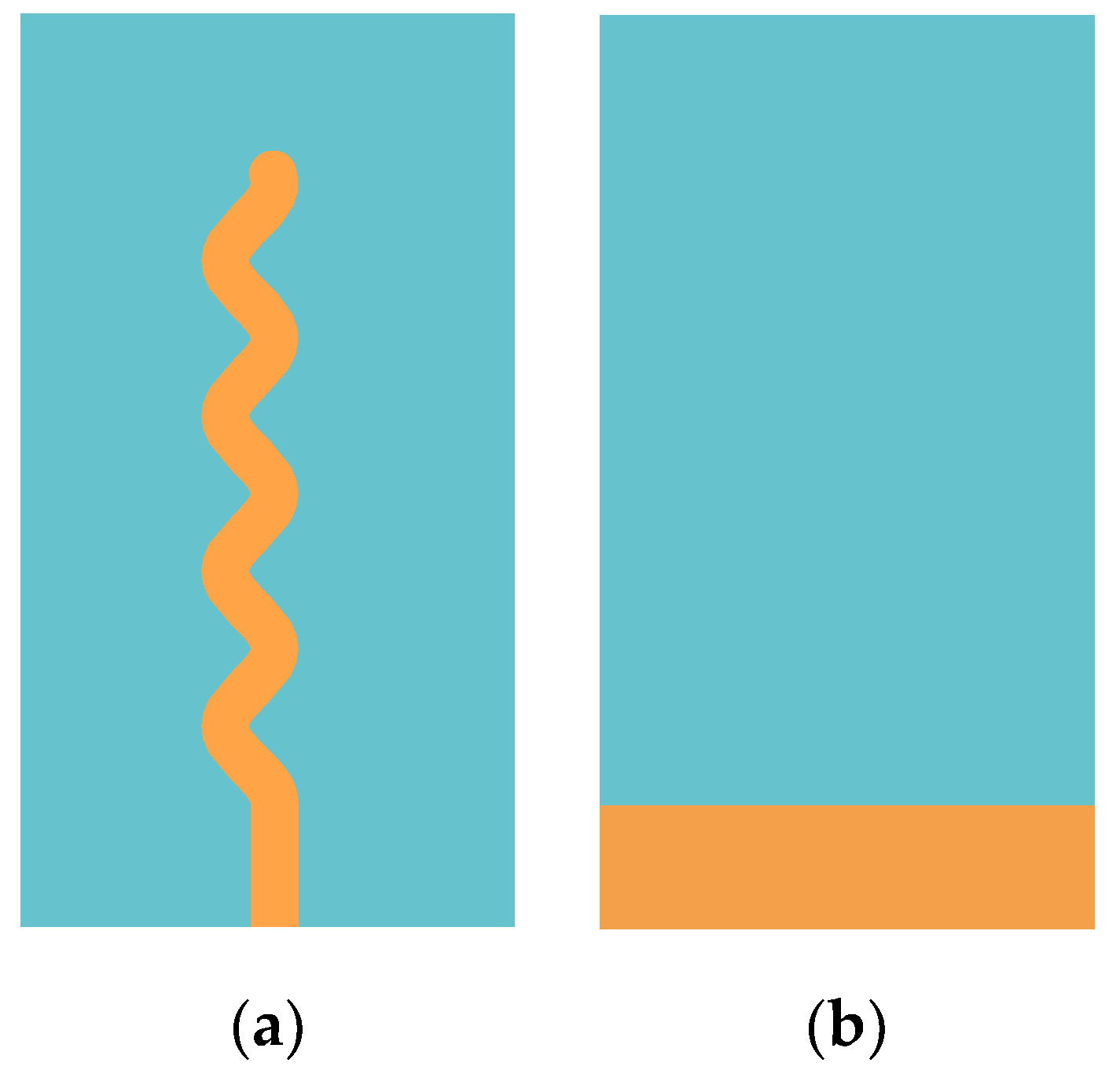
2.2.2. SRR for Frequency Band Expansion
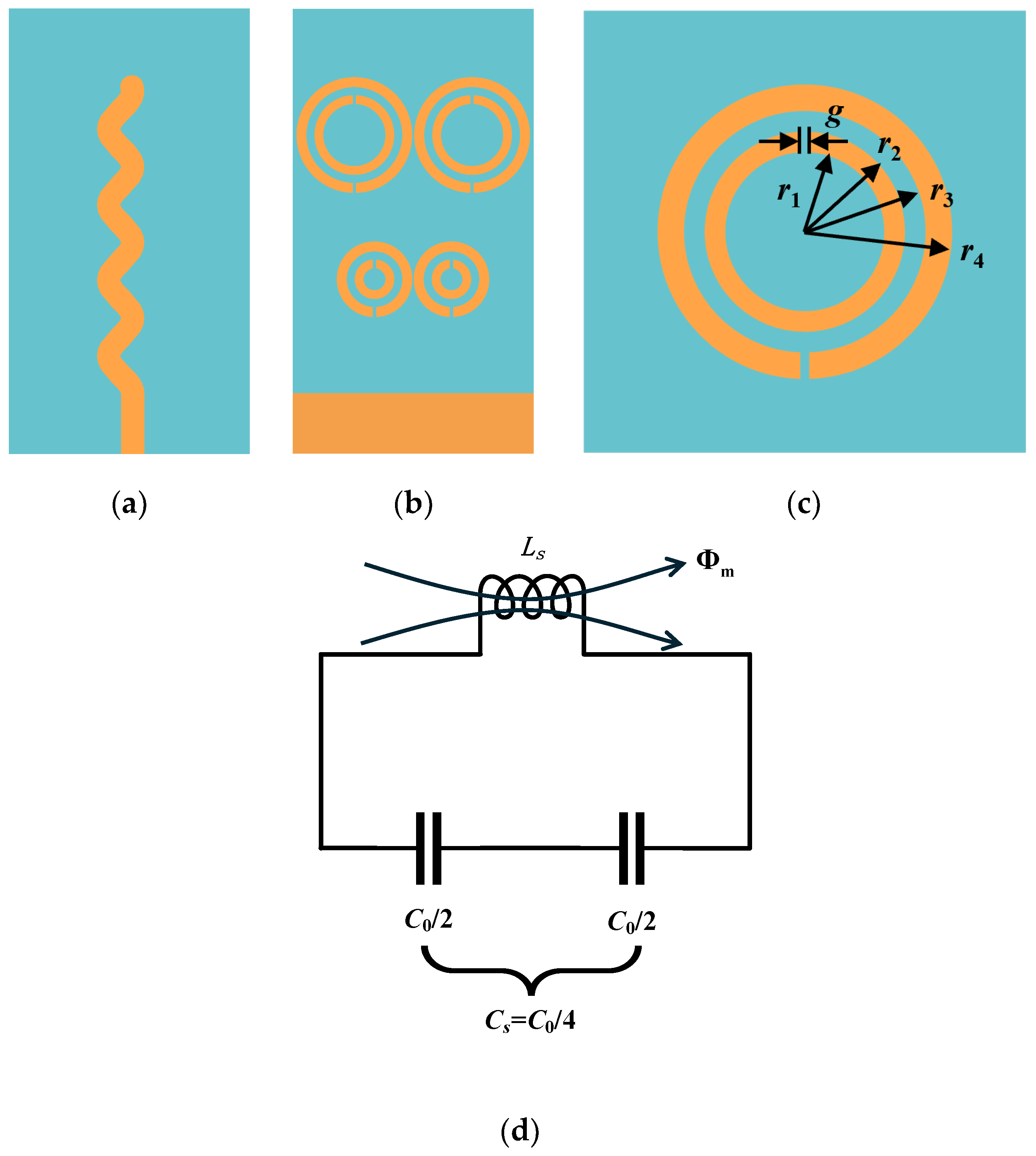
2.2.3. MIMO Structure
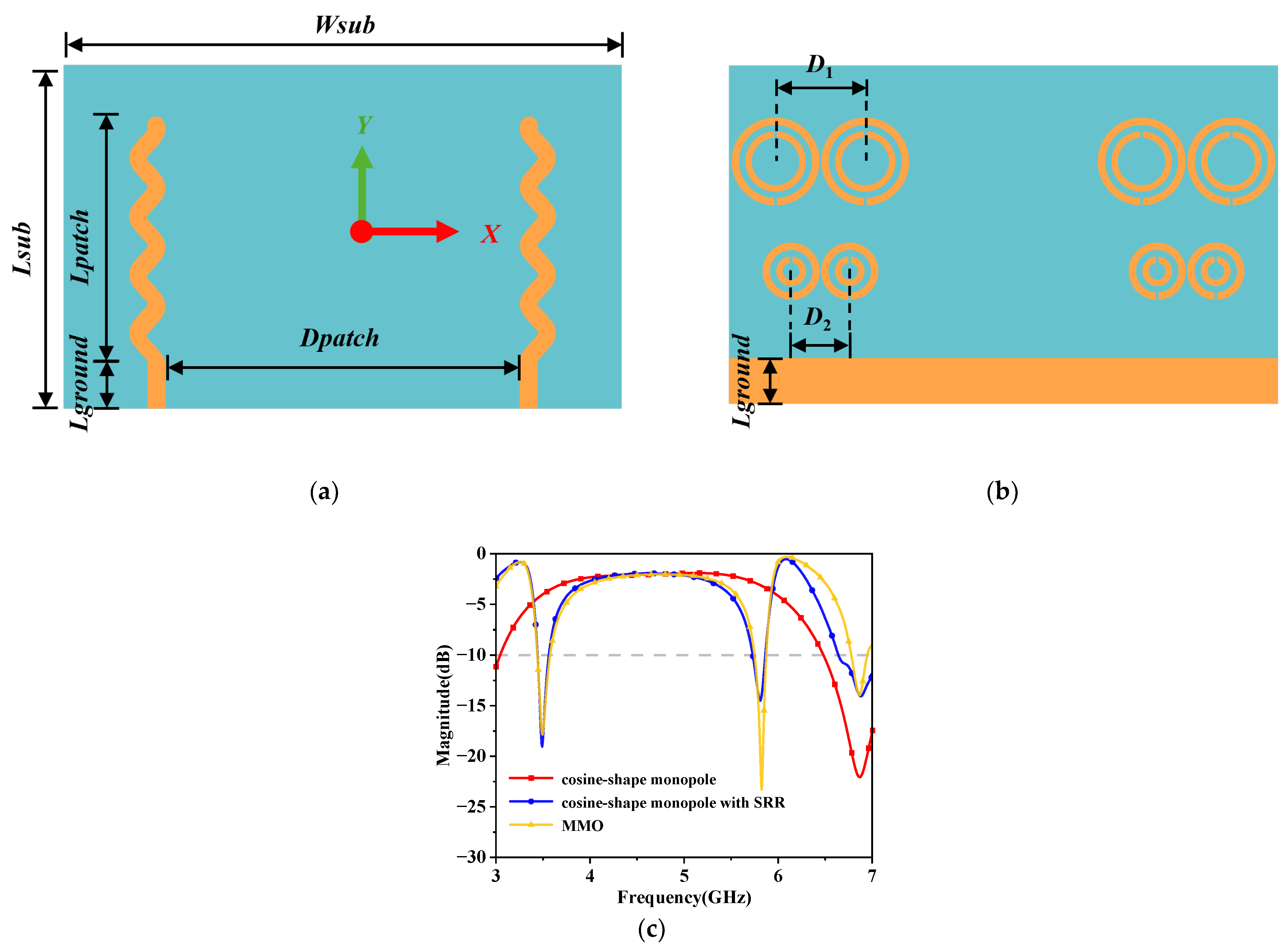
2.3. Design of the Decoupling Structures
2.3.1. FSRR for Decoupling
2.3.2. Metasurface for Decoupling
2.4. Decoupling Mechanism Analysis
3. Antenna Performance Analysis
- The signal source, network analyzer, source antenna, standard horn antenna, and antenna under test should be set up;
- The antenna to be tested is divided into two types—the one without metasurface and the one with metasurface. The metasurface and the antenna are drilled and connected with nylon bolts. The medium between the antenna radiation structure and the metasurface is air. The two antennas are independently excited, while the other antenna is terminated with a matched load;
- The antenna gain pattern is measured by the comparison method. The gain of the antenna to be measured is calculated by the signal power level Px received by the antenna to be measured, the signal power level Ps received by the standard horn antenna and the gain Gs of the standard horn antenna, as shown in Formula (14).
4. Conclusions
Author Contributions
Funding
Data Availability Statement
Conflicts of Interest
References
- Sun, L.; Feng, H.; Li, Y.; Zhang, Z. Compact 5G MIMO mobile phone antennas with tightly arranged orthogonal-mode pairs. IEEE Trans. Antennas Propag. 2018, 66, 6364–6369. [Google Scholar] [CrossRef]
- Hou, Z.; Liu, C.; Zhang, B.; Song, R.; Wu, Z.; Zhang, J.; He, D. Dual-/tri-wideband bandpass filter with high selectivity and adjustable passband for 5G mid-band mobile communications. Electronics 2020, 9, 205. [Google Scholar] [CrossRef]
- Ojaroudi Parchin, N.; Jahanbakhsh Basherlou, H.; Alibakhshikenari, M.; Ojaroudi Parchin, Y.; Al-Yasir, Y.I.A.; Abd-Alhameed, R.A.; Limiti, E. Mobile-phone antenna array with diamond-ring slot elements for 5G massive MIMO systems. Electronics 2019, 8, 521. [Google Scholar] [CrossRef]
- Park, S.; Kim, B.; Kim, I.; Seo, J.B. Deploying automated frequency coordination system for WiFi 6E in South Korea: Challenges and opportunities. IEEE Commun. Mag. 2024, 62, 112–118. [Google Scholar] [CrossRef]
- Lu, J.H.; Huang, B.J. Planar compact slot antenna with multi-band operation for IEEE 802.16m application. Trans. Antennas Propag. 2013, 61, 1411–1414. [Google Scholar] [CrossRef]
- Baek, J.G.; Hwang, K.C. Triple-band unidirectional circularly polarized hexagonal slot antenna with multiple L-shaped slits. Trans. Antennas Propag. 2013, 61, 4831–4835. [Google Scholar] [CrossRef]
- Cao, Y.F.; Cheung, S.W.; Yuk, T.I. A multiband slot antenna for GPS/WiMAX/WLAN systems. Trans. Antennas Propag. 2015, 63, 952–958. [Google Scholar] [CrossRef]
- Mehdipour, A.; Denidni, T.A.; Sebak, A.R. Multi-band miniaturized antenna loaded by ZOR and CSRR metamaterial structures with monopolar radiation pattern. Trans. Antennas Propag. 2014, 62, 555–562. [Google Scholar] [CrossRef]
- Takemura, N. Tunable Inverted-L Antenna with split-ring resonator structure for mobile phones. Trans. Antennas Propag. 2013, 61, 1891–1897. [Google Scholar] [CrossRef]
- Cheng, Y.F.; Cheng, K.K.M. Compact wideband decoupling and matching network design for dual-antenna array. IEEE Antennas Wirel. Propag. Lett. 2020, 19, 791–795. [Google Scholar] [CrossRef]
- Wu, C.H.; Chiu, C.L.; Ma, T.G. Very compact fully lumped decoupling network for a coupled two-element array. IEEE Antennas Wirel. Propag. Lett. 2016, 15, 158–161. [Google Scholar] [CrossRef]
- Zhao, L.; Wu, K.L. A dual-band coupled resonator decoupling network for two coupled antennas. IEEE Trans. Antennas Propag. 2015, 63, 2843–2850. [Google Scholar] [CrossRef]
- Qian, B.; Chen, X.; Kishk, A.A. Decoupling of microstrip antennas with defected ground structure using the common/differential mode theory. IEEE Antennas Wirel. Propag. Lett. 2021, 20, 828–832. [Google Scholar] [CrossRef]
- Wei, K.; Li, J.Y.; Wang, L.; Xing, Z.J.; Xu, R. Mutual coupling reduction by novel fractal defected ground structure bandgap filter. IEEE Trans. Antennas Propag. 2016, 64, 4328–4335. [Google Scholar] [CrossRef]
- Qian, B.; Chen, X.; Zhao, L.; Chen, J.; Kishk, A.A. Reduced cross-polarization and backside radiations for rectangular microstrip antennas using defected ground structure combined with decoupling structure. IEEE Antennas Wirel. Propag. Lett. 2023, 22, 517–521. [Google Scholar] [CrossRef]
- Niu, Z.; Zhang, H.; Chen, Q.; Zhong, T. Isolation enhancement for 1×3 closely spaced E-plane patch antenna array using defect ground structure and metal-vias. IEEE Access 2019, 7, 119375–119383. [Google Scholar] [CrossRef]
- Tan, X.; Wang, W.; Wu, Y.; Liu, Y.; Kishk, A.A. Enhancing isolation in dual-band meander-line multiple antenna by employing split EBG structure. IEEE Trans. Antennas Propag. 2019, 67, 2769–2774. [Google Scholar] [CrossRef]
- Yang, X.; Liu, Y.; Xu, Y.X.; Gong, S.X. Isolation enhancement in patch antenna array with fractal UC-EBG structure and cross slot. IEEE Antennas Wirel. Propag. Lett. 2017, 16, 2175–2178. [Google Scholar] [CrossRef]
- Qiu, L.; Zhao, F.; Xiao, K.; Chai, S.L.; Mao, J.J. Transmit–receive isolation improvement of antenna arrays by using EBG structures. IEEE Antennas Wirel. Propag. Lett. 2012, 11, 93–96. [Google Scholar]
- Dey, S.; Dey, S.; Koul, S.K. Isolation improvement of MIMO antenna using novel EBG and hair-pin shaped DGS at 5G millimeter wave band. IEEE Access 2021, 9, 162820–162834. [Google Scholar] [CrossRef]
- Bukhari, S.S.; Vardaxoglou, J.; Whittow, W. A metasurfaces review: Definitions and applications. Appl. Sci. 2019, 9, 2727. [Google Scholar] [CrossRef]
- Chen, Z.N. Microwave Metalens antennas. Proc. IEEE 2023, 111, 978–1010. [Google Scholar] [CrossRef]
- Wang, Z.; Li, C.; Wu, Q.; Yin, Y. A metasurface-based low-profile array decoupling technology to enhance isolation in MIMO antenna systems. IEEE Access 2020, 8, 125565–125575. [Google Scholar] [CrossRef]
- Munusami, C.; Venkatesan, R. A compact boat shaped dual-band MIMO antenna with enhanced isolation for 5G/WLAN application. IEEE Access 2024, 12, 11631–11641. [Google Scholar] [CrossRef]
- Liu, F.; Guo, J.; Zhao, L.; Huang, G.L.; Li, Y.; Yin, Y. Dual-band metasurface-based decoupling method for two closely packed dual-band antennas. IEEE Trans. Antennas Propag. 2020, 68, 552–557. [Google Scholar] [CrossRef]
- Wang, Z.; Li, C.; Yin, Y. A meta-surface antenna array decoupling (MAAD) design to improve the isolation performance in a MIMO system. IEEE Access 2020, 8, 61797–61805. [Google Scholar] [CrossRef]
- Wang, Z.; Tu, Z.H.; Yuan, Z.; Chen, F.C. Decoupling and wide-angle scanning design of a millimeter-wave phased array using square-ring metasurface. IEEE Antennas Wirel. Propag. Lett. 2023, 22, 1828–1832. [Google Scholar] [CrossRef]
- Abdullah, M.; Koziel, S. A novel versatile decoupling structure and expedited inverse-model-based re-design procedure for compact single-and dual-band MIMO antennas. IEEE Access 2021, 9, 37656–37667. [Google Scholar] [CrossRef]
- Sokunbi, O.; Kishk, A.A. Millimeter-wave me-dipole array antenna decoupling using a novel metasurface structure. IEEE Access 2023, 11, 129854–129865. [Google Scholar] [CrossRef]
- Zheng, M.; Wang, H.; Hao, Y. Internal hexa-band folded monopole/dipole/loop antenna with four resonances for mobile device. IEEE Trans. Antennas Propag. 2012, 60, 2880–2885. [Google Scholar] [CrossRef]
- Baena, J.D. Equivalent-circuit models for split-ring resonators and complementary split-ring resonators coupled to planar transmission lines. Trans. Microw. Theory Tech. 2005, 53, 1451–1461. [Google Scholar] [CrossRef]
- Askarian, A.; Yao, J.; Lu, Z.; Wu, K. Surface-wave control technique for mutual coupling mitigation in array antenna. IEEE Microw. Wirel. Compon. Lett. 2022, 32, 623–626. [Google Scholar] [CrossRef]
- Jafargholi, A.; Jafargholi, A.; Choi, J.H. Mutual coupling reduction in an array of patch antennas using CLL metamaterial superstrate for MIMO applications. Trans. Antennas Propag. 2019, 67, 179–189. [Google Scholar] [CrossRef]
- Caswell, E.D. Design and Analysis of Star Spiral with Application to Wideband Arrays with Variable Element Sizes. Ph.D. Thesis, Virginia Tech, Blacksburg, VA, USA, 2001. [Google Scholar]
- Constantine, A.B. Antenna Theory: Analysis and Design, 3rd ed.; John Wiley & Sons: Hoboken, NJ, USA, 2005; pp. 65–66. [Google Scholar]
- Iqbal, A.; A Saraereh, O.; Bouazizi, A.; Basir, A. Metamaterial-based highly isolated MIMO antenna for portable wireless applications. Electronics 2018, 7, 267. [Google Scholar] [CrossRef]

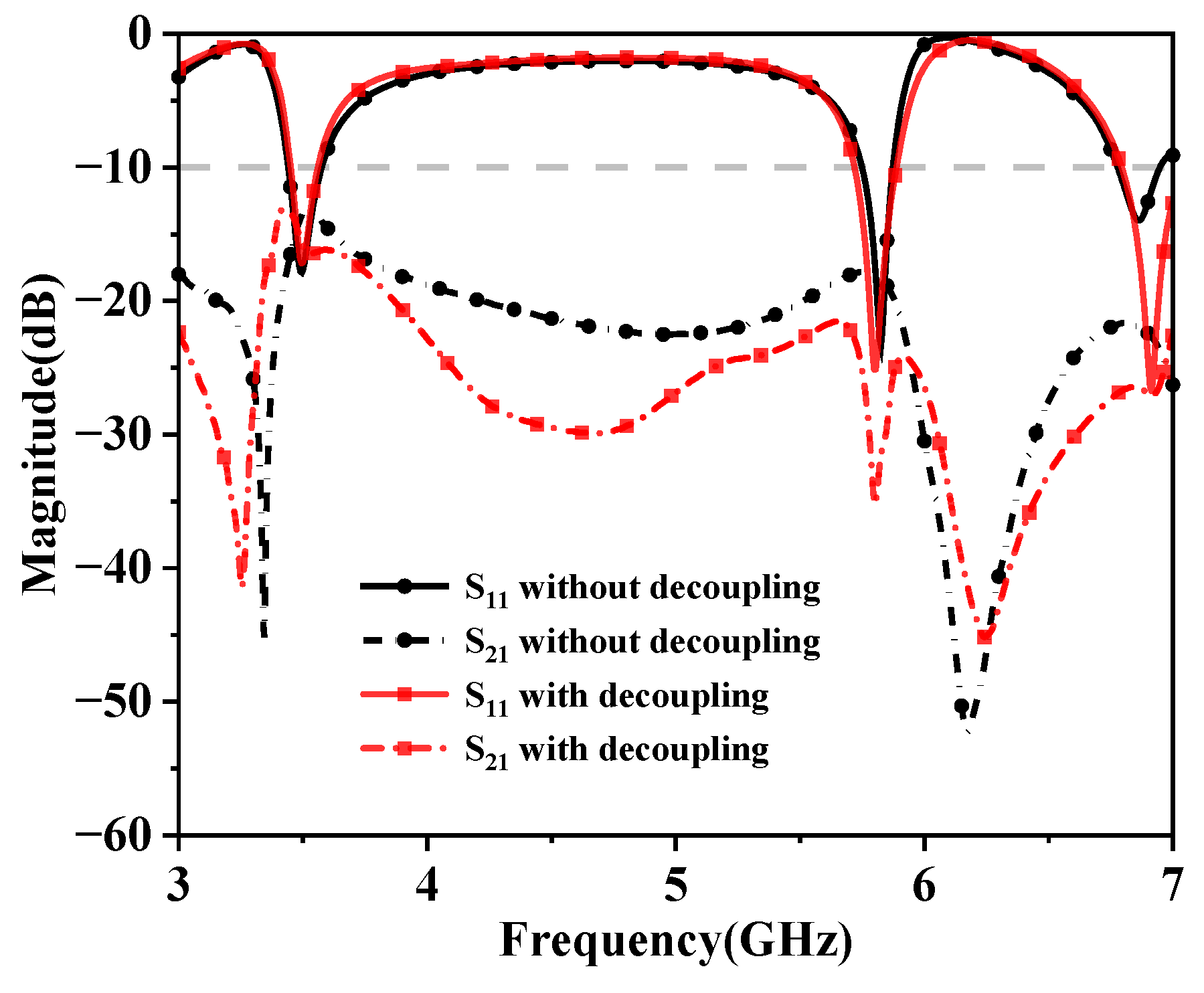
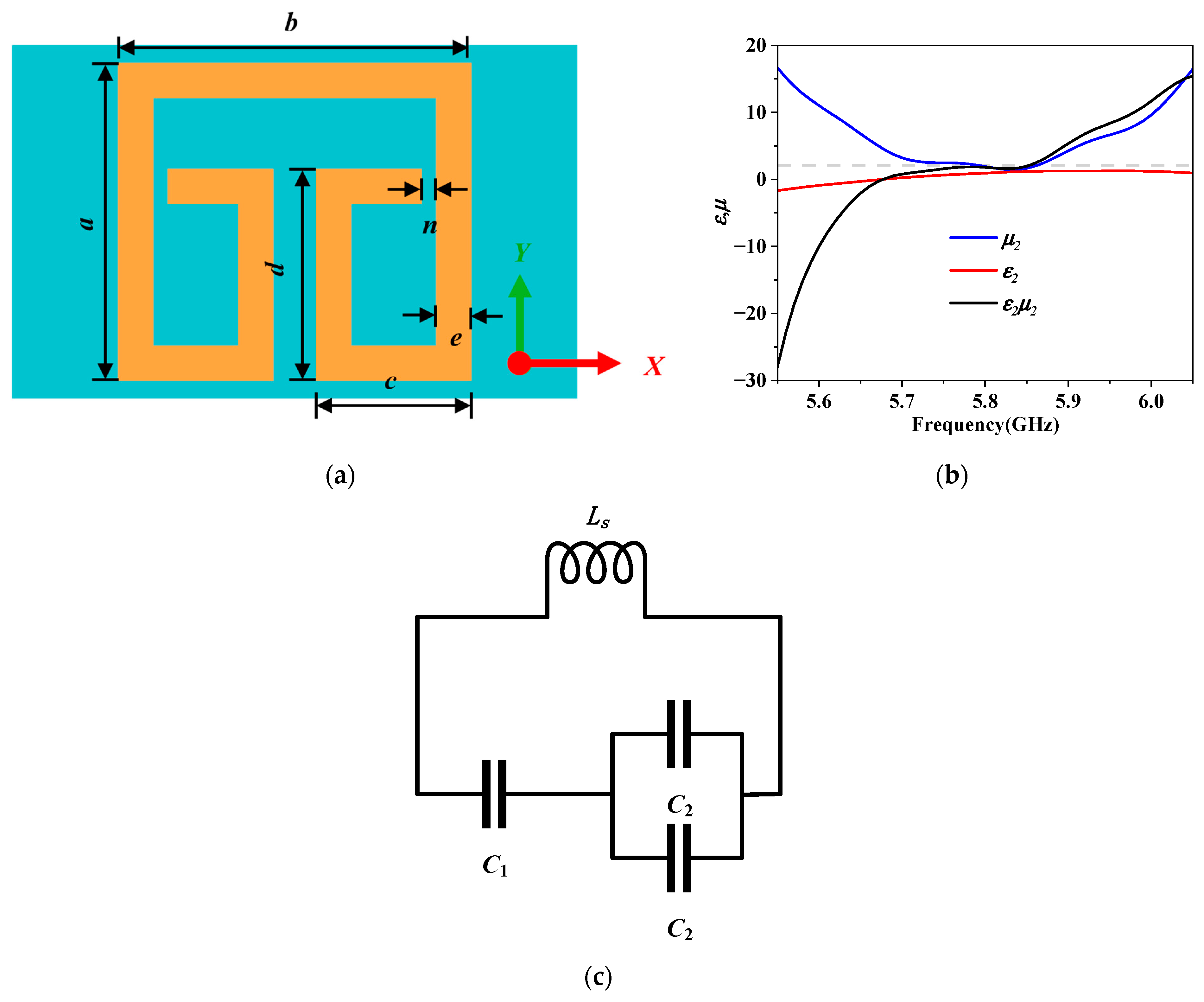


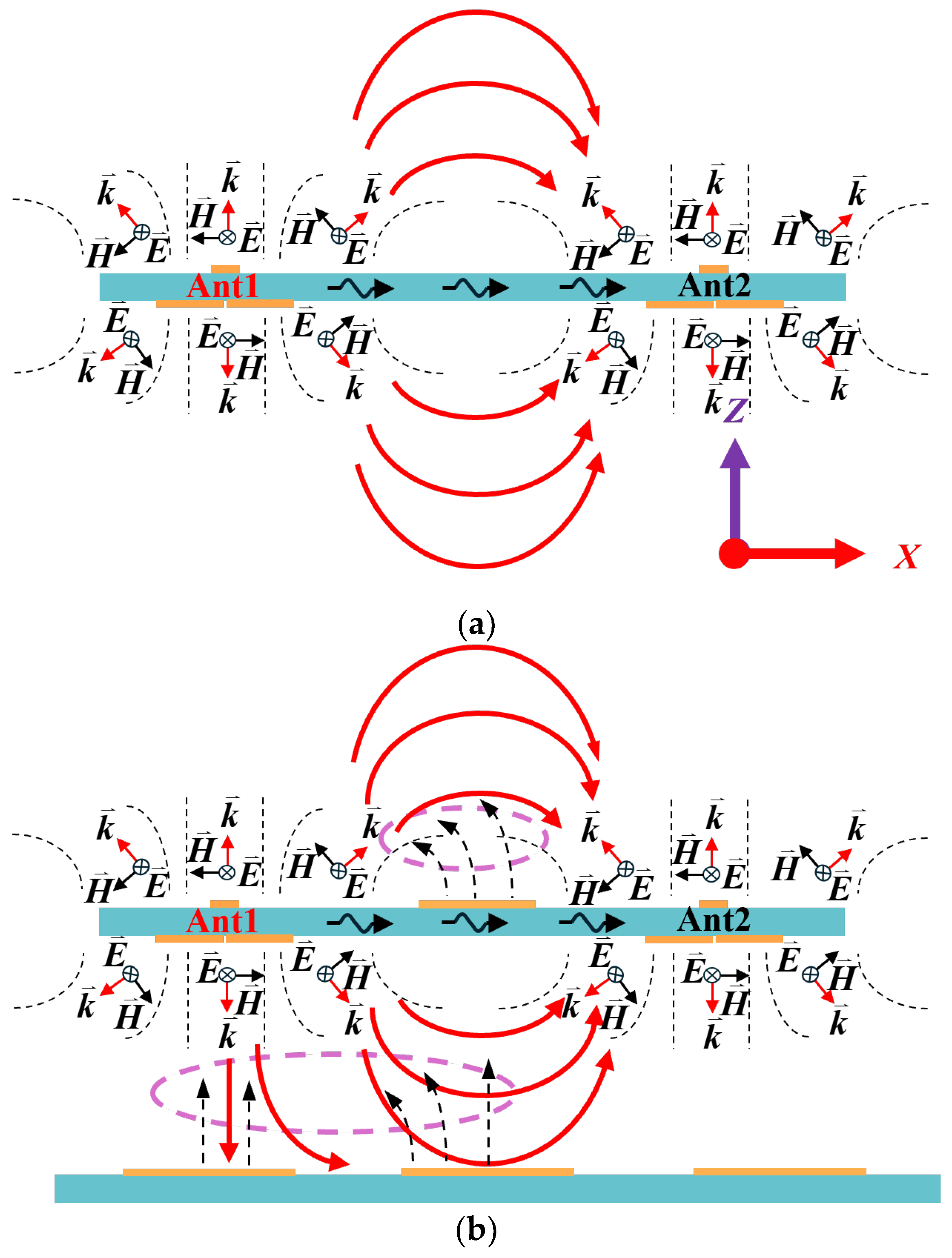
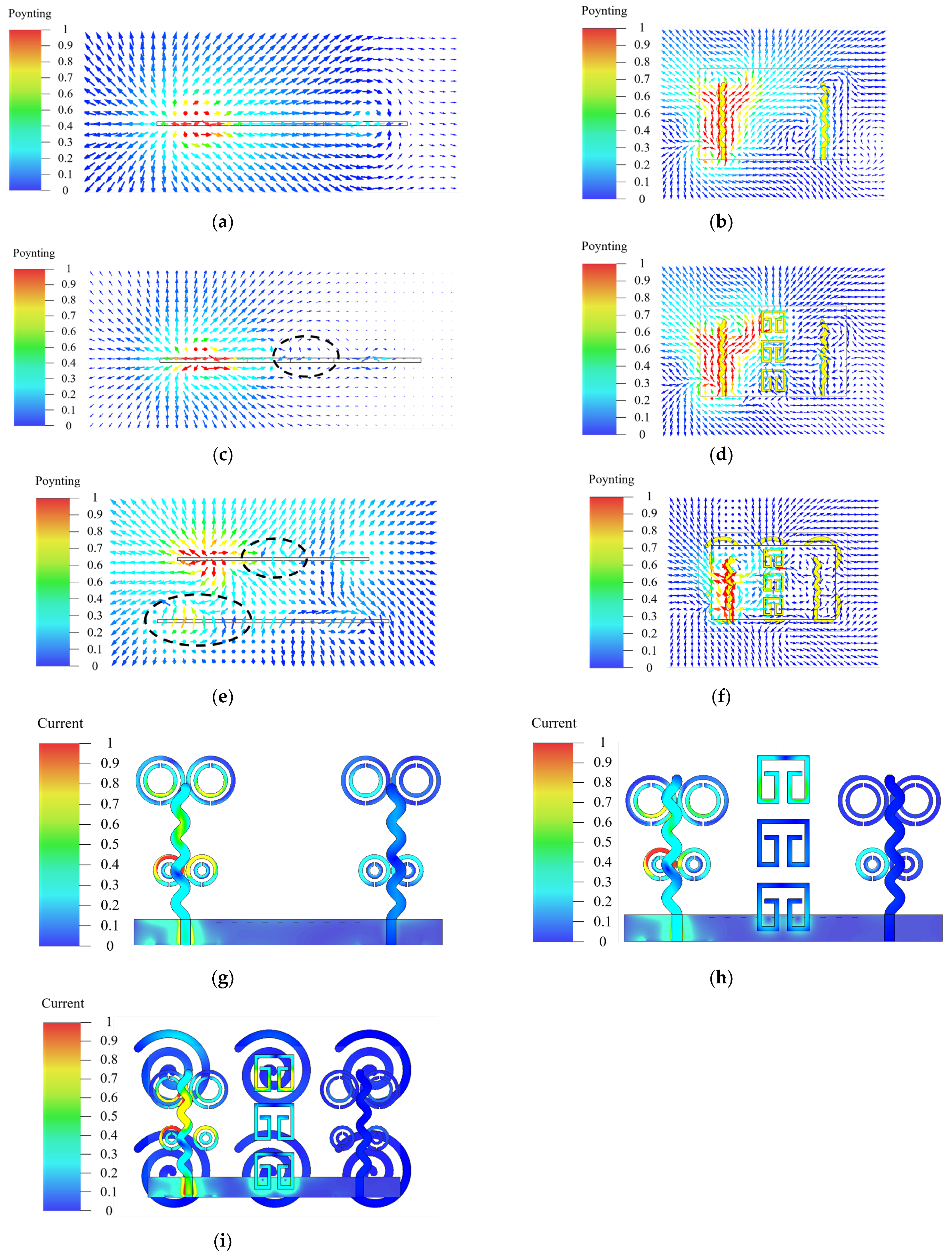
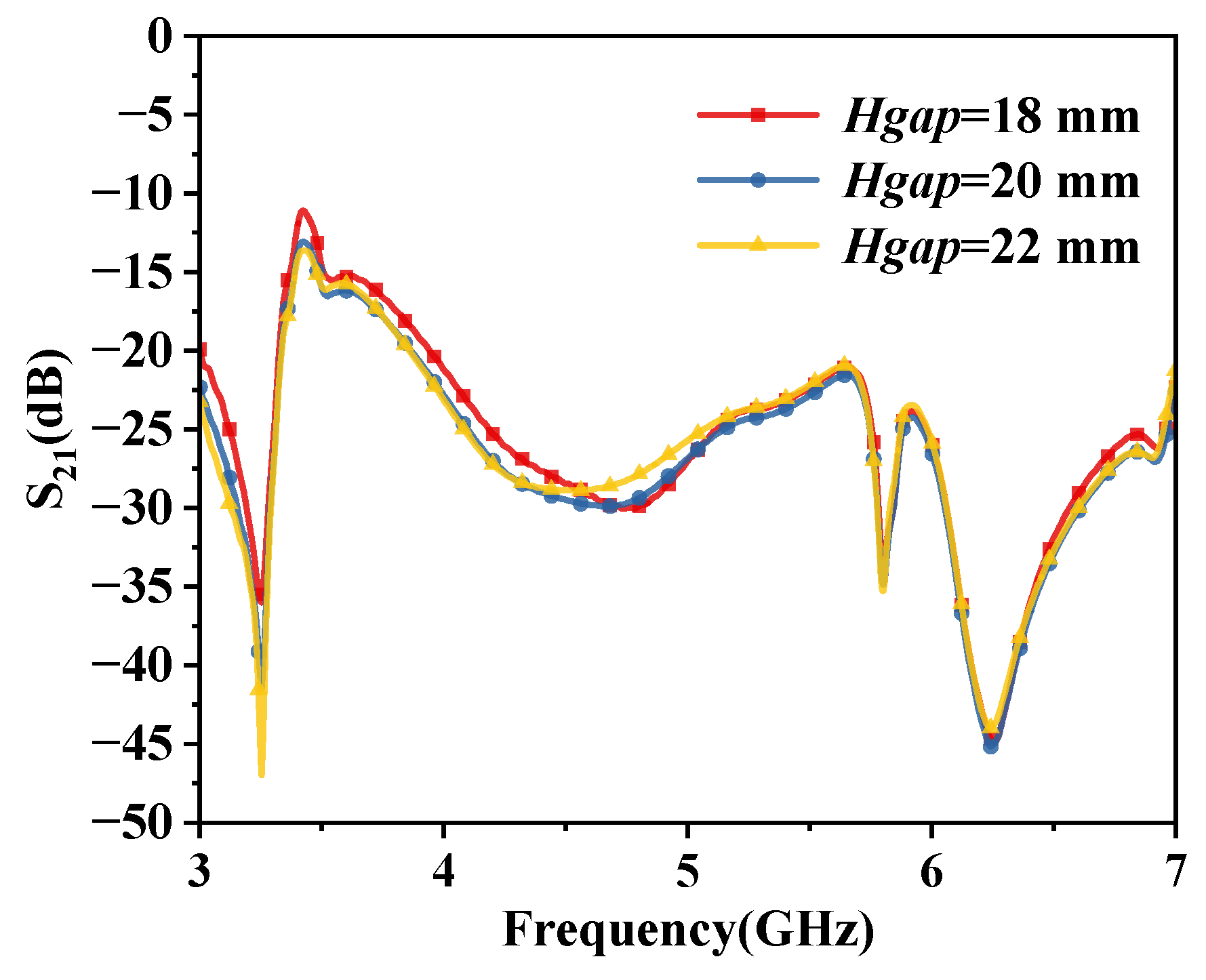
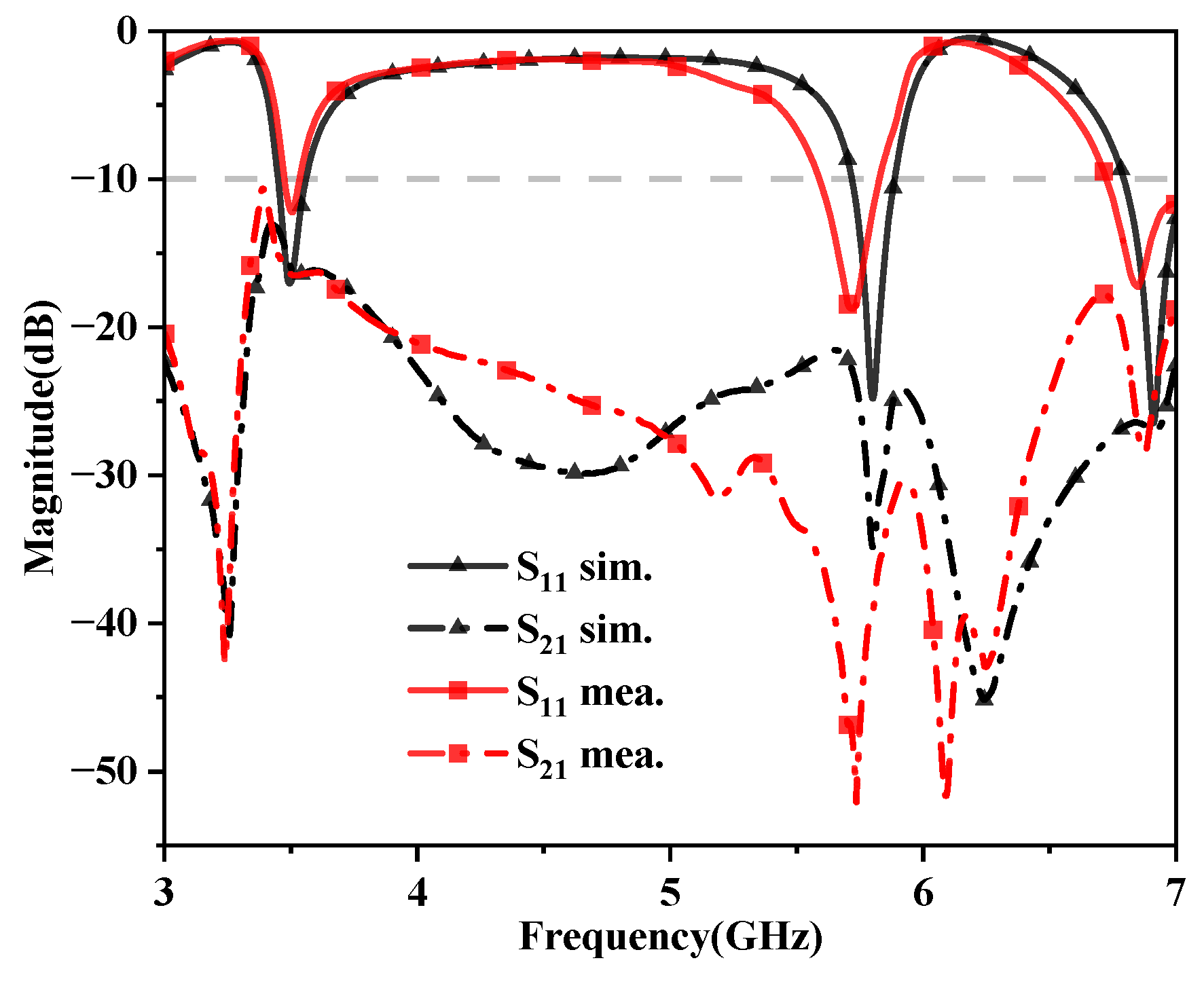
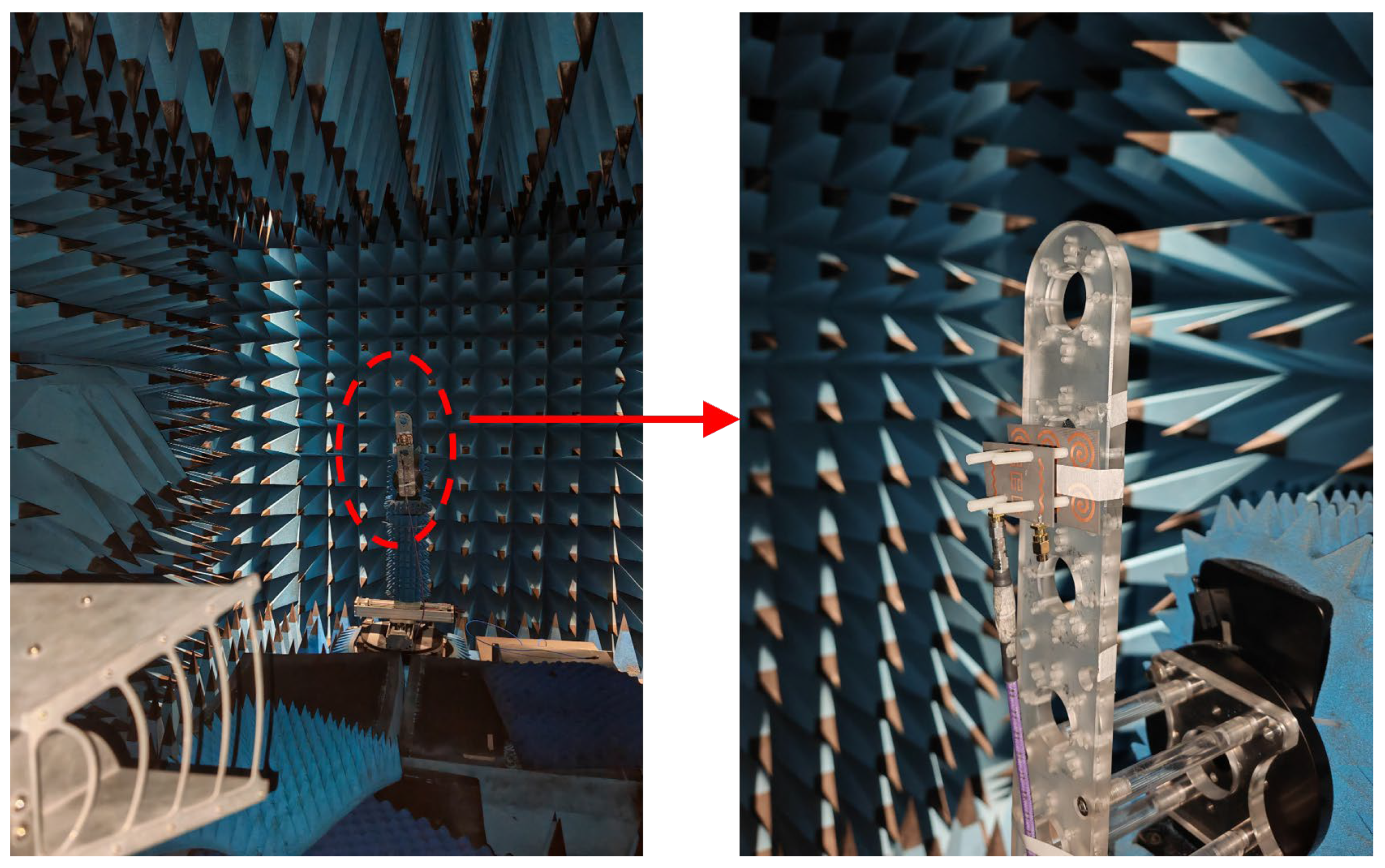
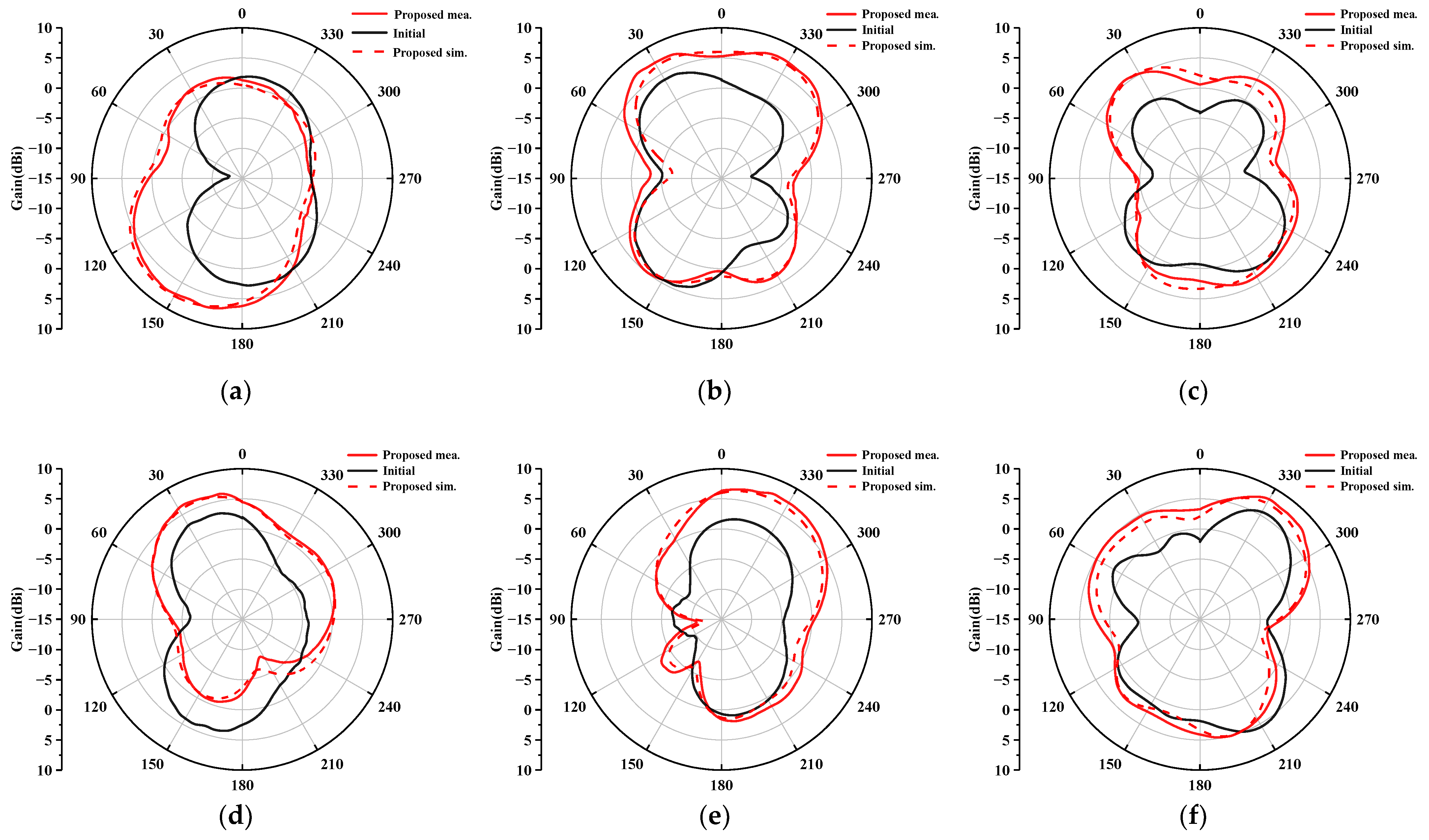
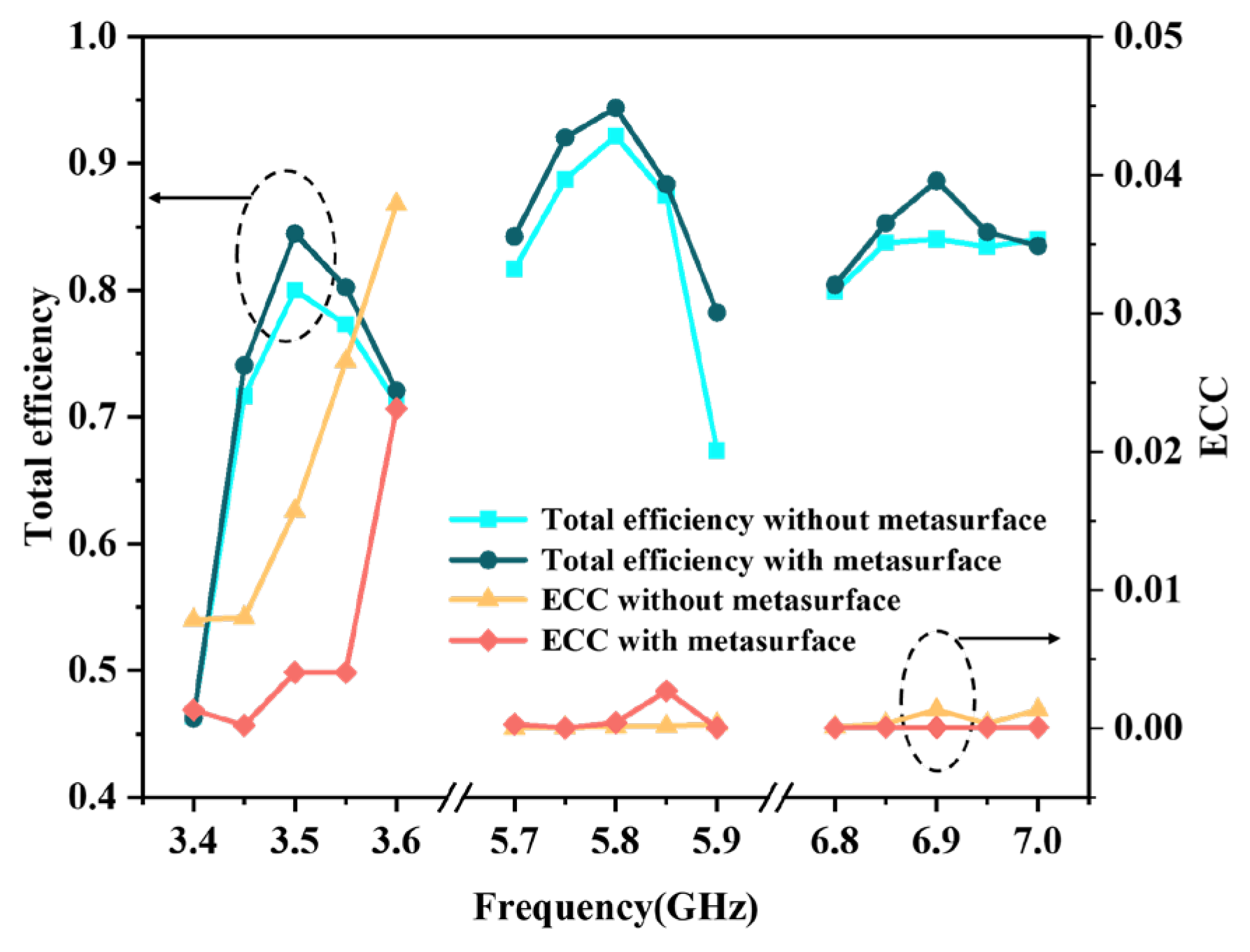
| Variable | Value | Variable | Value | Variable | Value |
|---|---|---|---|---|---|
| Wsub | 60 | Lground | 5 | r2 | 1.628/2.648 |
| Lsub | 37 | D1 | 8.4 | r3 | 2.328/3.348 |
| Lpatch | 25.5 | D2 | 6.4 | r4 | 3.128/4.148 |
| Dpatch | 28 | r1 | 0.828/1.848 | g | 0.1 |
| Variable | Value | Variable | Value | Variable | Value |
|---|---|---|---|---|---|
| Wsub2 | 75 | d | 6 | β | 0.9 |
| Lsub2 | 50 | e | 0.85 | θ | 4.5 π |
| a | 9 | n | 0.5 | e2 | 2 |
| b | 10.5 | t | 3 | ||
| c | 4 | α | 0.4 |
| Ref. | Method | Frequencies (GHz) | Spacing (Edge-to-Edge) | Height (mm) | Enhancement (dB) | ECC | Efficiency | Relative Bandwidth |
|---|---|---|---|---|---|---|---|---|
| [10] | DMN | 3.3–3.7 | 0.31 λ0 | 0 | 11–16 dB | <0.04 | 85% | 5.5% |
| [13] | DGS | 2.48 | 0.38 λ0 | 0 | 20 dB | <0.03 | 68% | 2% |
| [17] | EBG | 3.48/4.88 | 0.46 λL/0.65 λH | 0 | 2.8 dB/25 dB | <0.089 | 85% | 5.7%/9% |
| [14] | SRR | 5–6 | 0.06 l0 | 0.05 λ0 | 15 dB | <0.1 | 65–74% | 27.5% |
| [16] | Metasurface | 2.6/3.5 | 0.008 λL/0.01 λH | 0.095 λL | 30.4 dB/10.6 dB | <0.6 | 88%/67.5% | 7.5%/5.7% |
| Pro. | FSRR/Metasurface | 3.5/5.8/6.9 | 0.18 λL/0.29 λM/0.35 λH | 0.12 λL | 3.5 dB/36.47 dB/6.42 dB | <0.005 | 84%/94%/88% | 3%/5.8%/9.5% |
Disclaimer/Publisher’s Note: The statements, opinions and data contained in all publications are solely those of the individual author(s) and contributor(s) and not of MDPI and/or the editor(s). MDPI and/or the editor(s) disclaim responsibility for any injury to people or property resulting from any ideas, methods, instructions or products referred to in the content. |
© 2024 by the authors. Licensee MDPI, Basel, Switzerland. This article is an open access article distributed under the terms and conditions of the Creative Commons Attribution (CC BY) license (https://creativecommons.org/licenses/by/4.0/).
Share and Cite
Tang, G.; Xiao, T.; Cao, L.; Cheng, R.; Liu, C.; Huang, L.; Xu, X. A Multi-Frequency Low-Coupling MIMO Antenna Based on Metasurface. Electronics 2024, 13, 2146. https://doi.org/10.3390/electronics13112146
Tang G, Xiao T, Cao L, Cheng R, Liu C, Huang L, Xu X. A Multi-Frequency Low-Coupling MIMO Antenna Based on Metasurface. Electronics. 2024; 13(11):2146. https://doi.org/10.3390/electronics13112146
Chicago/Turabian StyleTang, Guangpu, Tong Xiao, Lifeng Cao, Runsheng Cheng, Chengguo Liu, Lifeng Huang, and Xin Xu. 2024. "A Multi-Frequency Low-Coupling MIMO Antenna Based on Metasurface" Electronics 13, no. 11: 2146. https://doi.org/10.3390/electronics13112146






